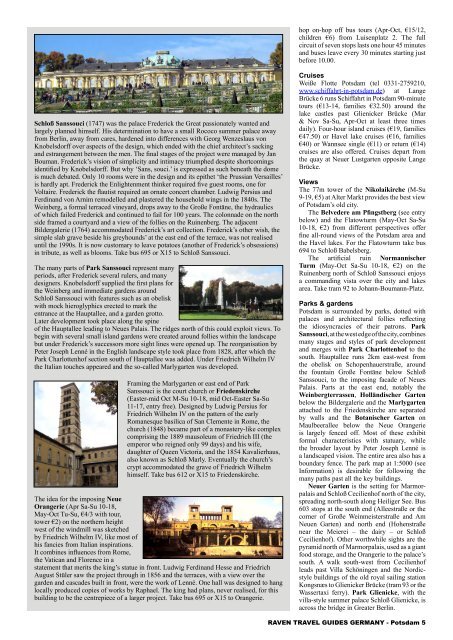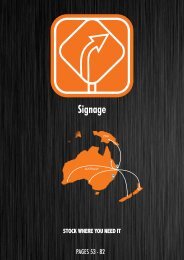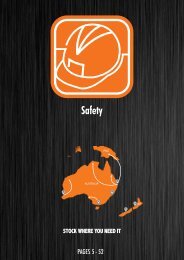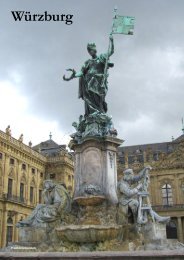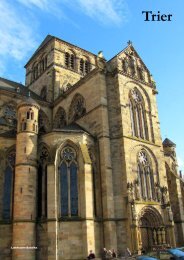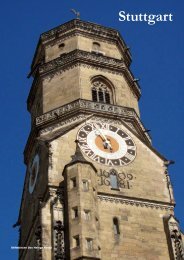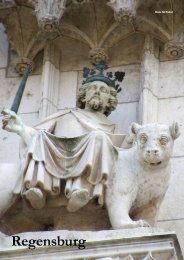Raven Guides: Germany - Potsdam
Create successful ePaper yourself
Turn your PDF publications into a flip-book with our unique Google optimized e-Paper software.
hop on-hop off bus tours (Apr-Oct, €15/12,<br />
children €6) from Luisenplatz 2. The full<br />
circuit of seven stops lasts one hour 45 minutes<br />
and buses leave every 30 minutes starting just<br />
before 10.00.<br />
Schloß Sanssouci (1747) was the palace Frederick the Great passionately wanted and<br />
largely planned himself. His determination to have a small Rococo summer palace away<br />
from Berlin, away from cares, hardened into differences with Georg Wenzeslaus von<br />
Knobelsdorff over aspects of the design, which ended with the chief architect’s sacking<br />
and estrangement between the men. The final stages of the project were managed by Jan<br />
Bouman. Frederick’s vision of simplicity and intimacy triumphed despite shortcomings<br />
identified by Knobelsdorff. But why ‘Sans, souci.’ is expressed as such beneath the dome<br />
is much debated. Only 10 rooms were in the design and its epithet ‘the Prussian Versailles’<br />
is hardly apt. Frederick the Enlightenment thinker required five guest rooms, one for<br />
Voltaire. Frederick the flautist required an ornate concert chamber. Ludwig Persius and<br />
Ferdinand von Arnim remodelled and plastered the household wings in the 1840s. The<br />
Weinberg, a formal terraced vineyard, drops away to the Große Fontäne, the hydraulics<br />
of which failed Frederick and continued to fail for 100 years. The colonnade on the north<br />
side framed a courtyard and a view of the follies on the Ruinenberg. The adjacent<br />
Bildergalerie (1764) accommodated Frederick’s art collection. Frederick’s other wish, the<br />
simple slab grave beside his greyhounds’ at the east end of the terrace, was not realised<br />
until the 1990s. It is now customary to leave potatoes (another of Frederick’s obsessions)<br />
in tribute, as well as blooms. Take bus 695 or X15 to Schloß Sanssouci.<br />
The many parts of Park Sanssouci represent many<br />
periods, after Frederick several rulers, and many<br />
designers. Knobelsdorff supplied the first plans for<br />
the Weinberg and immediate gardens around<br />
Schloß Sanssouci with features such as an obelisk<br />
with mock hieroglyphics erected to mark the<br />
entrance at the Hauptallee, and a garden grotto.<br />
Later development took place along the spine<br />
of the Hauptallee leading to Neues Palais. The ridges north of this could exploit views. To<br />
begin with several small island gardens were created around follies within the landscape<br />
but under Frederick’s successors more sight lines were opened up. The reorganisation by<br />
Peter Joseph Lenné in the English landscape style took place from 1828, after which the<br />
Park Charlottenhof section south of Hauptallee was added. Under Friedrich Wilhelm IV<br />
the Italian touches appeared and the so-called Marlygarten was developed.<br />
Framing the Marlygarten or east end of Park<br />
Sanssouci is the court church or Friedenskirche<br />
(Easter-mid Oct M-Su 10-18, mid Oct-Easter Sa-Su<br />
11-17, entry free). Designed by Ludwig Persius for<br />
Friedrich Wilhelm IV on the pattern of the early<br />
Romanesque basilica of San Clemente in Rome, the<br />
church (1848) became part of a monastery-like complex<br />
comprising the 1889 mausoleum of Friedrich III (the<br />
emperor who reigned only 99 days) and his wife,<br />
daughter of Queen Victoria, and the 1854 Kavalierhaus,<br />
also known as Schloß Marly. Eventually the church’s<br />
crypt accommodated the grave of Friedrich Wilhelm<br />
himself. Take bus 612 or X15 to Friedenskirche.<br />
The idea for the imposing Neue<br />
Orangerie (Apr Sa-Su 10-18,<br />
May-Oct Tu-Su, €4/3 with tour,<br />
tower €2) on the northern height<br />
west of the windmill was sketched<br />
by Friedrich Wilhelm IV, like most of<br />
his fancies from Italian inspirations.<br />
It combines influences from Rome,<br />
the Vatican and Florence in a<br />
statement that merits the king’s statue in front. Ludwig Ferdinand Hesse and Friedrich<br />
August Stüler saw the project through in 1856 and the terraces, with a view over the<br />
garden and cascades built in front, were the work of Lenné. One hall was designed to hang<br />
locally produced copies of works by Raphael. The king had plans, never realised, for this<br />
building to be the centrepiece of a larger project. Take bus 695 or X15 to Orangerie.<br />
Cruises<br />
Weiße Flotte <strong>Potsdam</strong> (tel 0331-2759210,<br />
www.schiffahrt-in-potsdam.de) at Lange<br />
Brücke 6 runs Schiffahrt in <strong>Potsdam</strong> 90-minute<br />
tours (€13-14, families €32.50) around the<br />
lake castles past Glienicker Brücke (Mar<br />
& Nov Sa-Su, Apr-Oct at least three times<br />
daily). Four-hour island cruises (€19, families<br />
€47.50) or Havel lake cruises (€16, families<br />
€40) or Wannsee single (€11) or return (€14)<br />
cruises are also offered. Cruises depart from<br />
the quay at Neuer Lustgarten opposite Lange<br />
Brücke.<br />
Views<br />
The 77m tower of the Nikolaikirche (M-Su<br />
9-19, €5) at Alter Markt provides the best view<br />
of <strong>Potsdam</strong>’s old city.<br />
The Belvedere am Pfingstberg (see entry<br />
below) and the Flatowturm (May-Oct Sa-Su<br />
10-18, €2) from different perspectives offer<br />
fine all-round views of the <strong>Potsdam</strong> area and<br />
the Havel lakes. For the Flatowturm take bus<br />
694 to Schloß Babelsberg.<br />
The artificial ruin Normannischer<br />
Turm (May-Oct Sa-Su 10-18, €2) on the<br />
Ruinenberg north of Schloß Sanssouci enjoys<br />
a commanding vista over the city and lakes<br />
area. Take tram 92 to Johann-Boumann-Platz.<br />
Parks & gardens<br />
<strong>Potsdam</strong> is surrounded by parks, dotted with<br />
palaces and architectural follies reflecting<br />
the idiosyncracies of their patrons. Park<br />
Sanssouci, at the west edge of the city, combines<br />
many stages and styles of park development<br />
and merges with Park Charlottenhof to the<br />
south. Hauptallee runs 2km east-west from<br />
the obelisk on Schopenhauerstraße, around<br />
the fountain Große Fontäne below Schloß<br />
Sanssouci, to the imposing facade of Neues<br />
Palais. Parts at the east end, notably the<br />
Weinbergterrassen, Holländischer Garten<br />
below the Bildergalerie and the Marlygarten<br />
attached to the Friedenskirche are separated<br />
by walls and the Botanischer Garten on<br />
Maulbeerallee below the Neue Orangerie<br />
is largely fenced off. Most of these exhibit<br />
formal characteristics with statuary, while<br />
the broader layout by Peter Joseph Lenné is<br />
a landscaped vision. The entire area also has a<br />
boundary fence. The park map at 1:5000 (see<br />
Information) is desirable for following the<br />
many paths past all the key buildings.<br />
Neuer Garten is the setting for Marmorpalais<br />
and Schloß Cecilienhof north of the city,<br />
spreading north-south along Heiliger See. Bus<br />
603 stops at the south end (Alleestraße or the<br />
corner of Große Weinmeisterstraße and Am<br />
Neuen Garten) and north end (Hohenstraße<br />
near the Meierei – the dairy – or Schloß<br />
Cecilienhof). Other worthwhile sights are the<br />
pyramid north of Marmorpalais, used as a giant<br />
food storage, and the Orangerie to the palace’s<br />
south. A walk south-west from Cecilienhof<br />
leads past Villa Schöningen and the Nordicstyle<br />
buildings of the old royal sailing station<br />
Kongsnæs to Glienicker Brücke (tram 93 or the<br />
Wassertaxi ferry). Park Glienicke, with the<br />
villa-style summer palace Schloß Glienicke, is<br />
across the bridge in Greater Berlin.<br />
RAVEN TRAVEL GUIDES GERMANY - <strong>Potsdam</strong> 5


